1960 Dutch Grand Prix race report: Brabham throws kitchen sink (and more) at Moss to win
Loose paving stone proves the difference as Jack Brabham emerges victorious from titanic battle with Stirling Moss; Englishman battles back from 12th to 4th
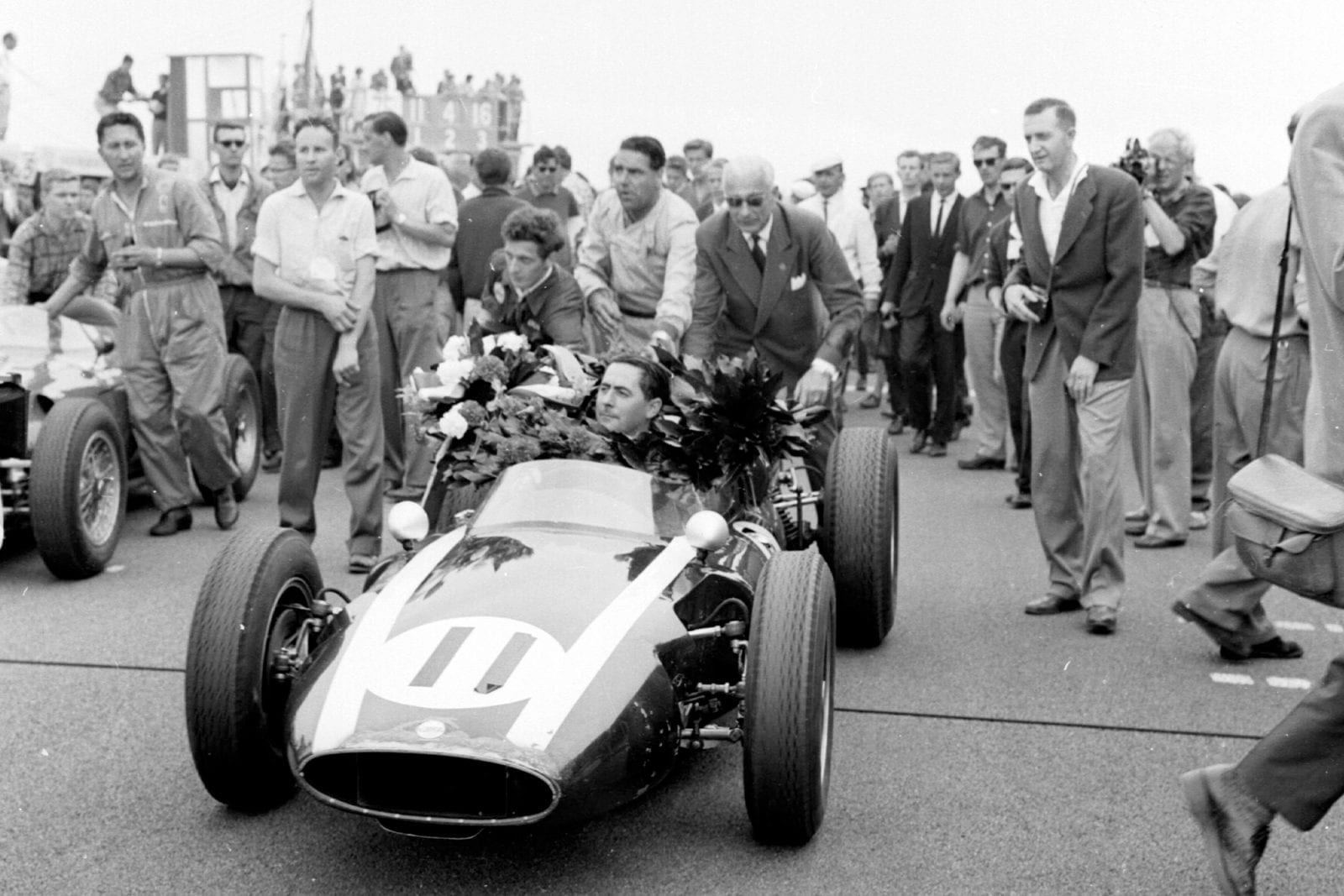
Jack Brabham takes the plaudits upon winning
Motorsport Images
For some reason best known to themselves, the FIA broke one of their own rules when they sanctioned the holding of the Dutch Grand Prix just one week after the Monaco Grand Prix, for International rules say there should be a minimum of a fortnight between major races. Luckily the Dutch race was scheduled for Whit-Monday and practice on the previous Saturday and Sunday, but, bearing in mind the wreckage after the Monte Carlo race and the fact that the two circuits are nearly 1,000 miles apart, there was a lot of overtime put in by the mechanics of the various teams.
Most of the entrants from Monaco were at Zandvoort, with the addition of Aston Martin, making their first Continental appearance this season. Brabham’s Cooper had to return to Surbiton to be bent straight on the building jig, the BRM team brought out a brand new car to replace the one crashed by Graham Hill, while all three cars had to have the rear suspension uprights reinforced and engines were changed, there being a remarkable number of BRM engines about the place at Zandvoort—some on their way back to Bourne for overhaul, new ones to put in the cars, and spare ones just in case.
Lotus did all their work at Monte Carlo before leaving, having to straighten the chassis on Ireland’s car due to being bent by kerb-clouting, new engine mountings had to be fitted on Stacey’s car, and the gearbox rebuilt on the third car. Ferrari overhauled their front-engined cars and also dismantled the rear-engined car to inspect everything, after its first race. The front-engined cars were fitted with anti-roll bars on the rear suspension.
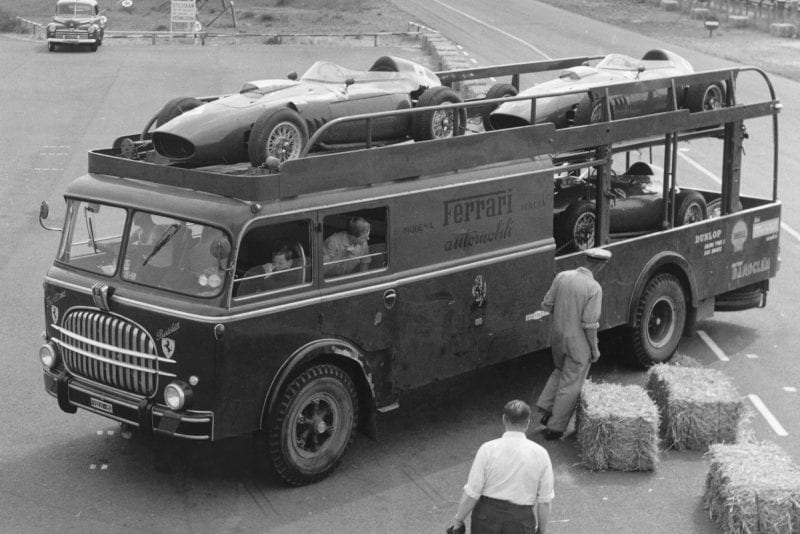
The Ferrari team arrives at the circuit
Motorsport Images
The Scarabs arrived early and ready to go, once axle ratios had been settled, and Aston Martin had their 1960 car ready and a 1959 one standing by as spare. The Yeoman Credit Team repaired Bristow’s car and had three Formula One cars, and a 2-litre car as spare, for in this race they were giving Henry Taylor a try-out as well as retaining Brooks and Bristow. CentroSud had only two of their Cooper-Maseratis, for Trintignant and Gregory, while the entry list was made up to 21 cars by the Dutchman de Beaufort with a brand new F2 Cooper-Climax, made 4in longer in the cockpit to accommodate his great length.
Taking a leaf from the book of the Monaco organisers, the Dutch decided to have qualifying conditions for the entry, and though 21 cars were invited only 15 were due to start, these being the fastest 15 in practice. Instead of the fastest practice lap to count, the three fastest laps by each driver were to be taken and added together. On a track such as Zandvoort, where 25 cars could easily be accommodated, it was difficult to see why only 15 were going to be accepted if, as was suggested, total starting money was limited then why not divide it by 20 instead of 15, so that more people could be certain to race, and not give the “stars” quite so much gold.
With Allison still in hospital, the Ferrari team comprised Phil Hill, von Trips and Ginther; Lotus had lost Surtees, as he had gone to the Isle of Man to do some serious motorcycle racing, so they had Ireland, Stacey and Clark, the last-named being a worthy substitute; Moss was still driving for RRC Walker; Yeoman Credit had Brooks, Bristow and Taylor; Coopers their two “down-unders” Brabham and McLaren; BRM had Bonnier, Gurney and Graham Hill; Aston Martin had only one entry, for Salvadori; Trintignant and Gregory were driving for Centro-Sud, de Beaufort for himself; and Reventlow and Daigh were again on the Scarabs.
With nearly everyone coming from Monte Carlo there was not much to be seen on the technical scene, except that Aston Martin resurrected the de Dion axle, after it was deemed dead and buried at Monaco, and they were also stuck with front-engine, the new six-cylinder having its inlets and exhausts reversed from last year and using Lucas low-pressure fuel-injection with a battery-driven electric pump supplying the pressure.
This new car has reverted to torsion-bar front suspension, though now running longitudinally and coupled to a strong I-section arm which forms, effectively, a lower wishbone of the front suspension, there being a normal top one. At the rear the de Dion tube now runs across the car ahead of the gearbox/ differential unit, guided by a pad running in a slot on the front of the unit, and at its ends by double radius rods. As the final drive unit is Maserati 250F of 1957 design, this re-positioning of the de Dion is understandable; longitudinal torsion bars are coupled to the hub carriers by short links, and, as at the front, telescopic shock-absorbers are used.
The Zandvoort track being a permanent circuit, available at all times, an unofficial try-out session was allowed on the Friday evening, during which time Clark had the bottom-gear pinion of his Lotus fly apart, the BRM with rear engine seemed as well suited to the circuit as the old front-engined cars did, Aston Martin were showing that their fuel-injection gave beautifully clean pick-up out of corners, especially compared with Lotus tuning, but the 1960 car was not so stable as the older and heavy car, and McLaren was working hard with the 1960 Cooper, it not looking so easy to drive as last year’s cars.
Qualifying
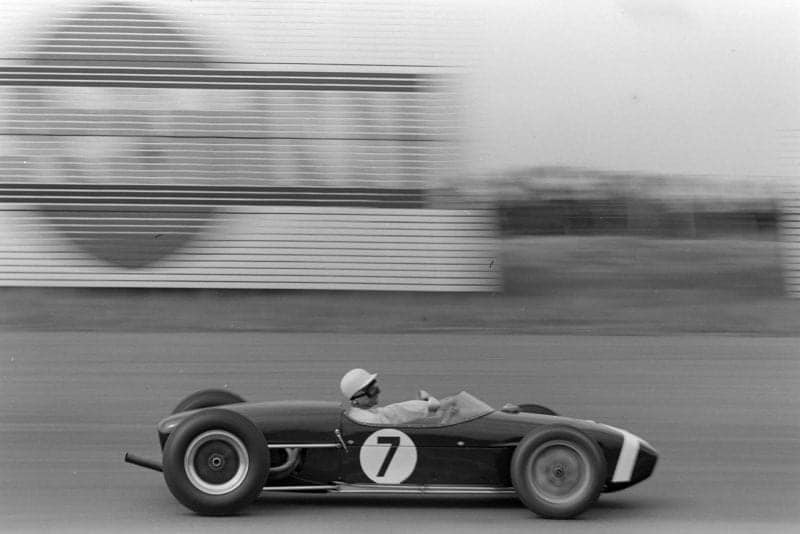
Moss puts the laps in
Motorsport Images
On the Saturday morning official practice began and the race against time started, with Moss being easily the fastest of all, with a lap in 1min 33.8sec, which made sense against last year’s fastest practice lap of 1min 36.0sec, remembering the progress in technical development, if not in design, since last year. The Ferrari drivers were not happy with their handling (but then they seldom are), the rear anti-roll bars altering the handling to the opposite extreme.
Yeoman Credit gave Henry Taylor a run in their 2-litre car before letting him loose in one of the Formula 1 cars, and the Lotus team were performing more to the standard expected of them after their showing at Goodwood and Silverstone. The Scarabs were still slow, but not so bad that they had no hope. With the regulations taking the three best times by each driver there was no way of following the progress of practice until it was all over, and this was something the organisers had overlooked, for it meant that it would not be possible to decide on the lucky 15 starters until all practice was over, so there would be no last-minute attempts to qualify.
“The Scarabs were still slow, but not so bad that they had no hope”
Before the next practice session took place, on the Saturday afternoon, the organisers received a deputation from the entrants and this matter was thrashed out, and the decision made to scrub the rule and take only the fastest lap by each driver to count for qualification. It was also agreed that a maximum of 20 cars would be permitted to start, but it was not going to be possible to pay starting money to the extra five cars. These were very reasonable decisions made by the Dutch organisers, unlike some organisers who will not even listen to the entrants’ complaints, let alone change regulations, but it was not enough for the entrants for they all wanted starting money, whether they were in the first 15 or not, but quite justifiably the organisers turned that one down.
The afternoon practice saw everyone out again except Bonnier, who had broken his BRM gearbox in the morning, and anyone who considered himself a driver, or a car that could be rated as a Grand Prix car, was well below 1min 40sec. Once again Moss was by far the fastest, with 1min 33.6sec, his nearest rival being Brabham with 1min 34.5sec.
The Scarabs were improving, Daigh getting down to 1min 42.7sec, but Reventlow could not even beat de Beaufort with his Formula 2 Cooper. The Aston Martin was not happy, lacking power for its weight, as always, and Salvadori not being convinced about the handling, though it did not look too bad around the circuit, and sounded wonderful.
In the morning it had been credited with 1min 37.8sec, but it never approached that again, being unable to crack 1min 40sec. Gurney was not looking at all happy in the rear-engined BRM, seeming to work unnecessarily at correcting rear-wheel movements that were not really there, whereas Graham Hill looked completely relaxed and almost bored while he was doing 1min 35.1sec.
Taylor was enjoying himself in the Yeoman Credit car and, although putting a lot of effort into his driving, he was going well and had a big dice with Ginther in a front-engined Ferrari, finally catching him, but meanwhile Phil Hill in another front-engined car caught and passed them both, going very fast and clocking 1min 36.4sec.
Bristow was driving very fast indeed and even caught and passed his team-mate Brooks, although by the end of the afternoon they had both recorded 1min 37.6sec, slower than they had done in the morning. The Centro-Sud cars were going quite well and Gregory was looking tremendously exciting, continually on opposite lock, but, nevertheless, Trintignant was faster.
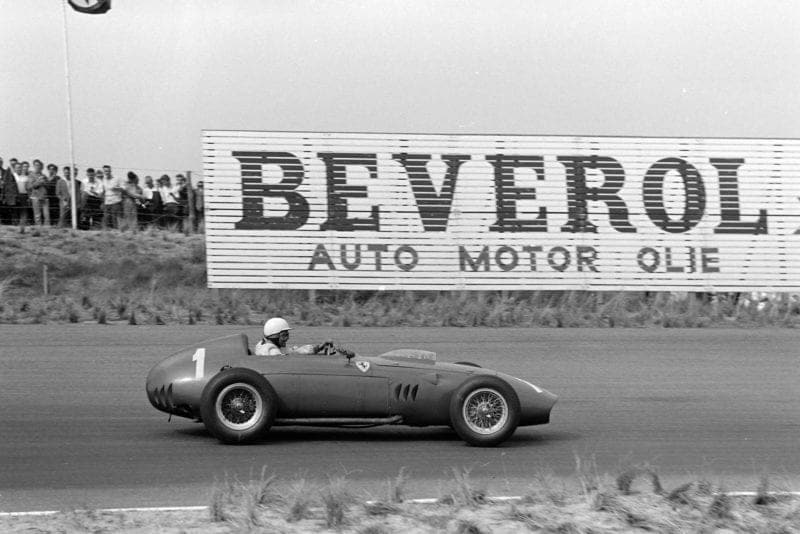
Phill Hill qualified a disappointing 13th
Motorsport Images
When this second practice session finished there was still a lot of unrest among the also-rans, saying they would not start without being paid, even though the organisers had agreed to take 26 cars. Just why anyone who is not good enough to qualify against the best should be worth any money at all is one of those mysteries that form part of the big-business of motor racing.
Next day, Sunday, there was one practice session in the afternoon, and once again Moss set the pace with 1min 33.8sec, but he was not so secure this time, for Brabham was out there really working with the new Cooper, and after driving in a manner that all could see was right on the limit, be docked 1min 33.4sec. This did not please Moss, especially as Ireland had recorded 1min 33.9sec, also working at a high pressure, so he went out again, first on very worn rear tyres and, then on not-so-worn ones, and finally recorded 1min 33.2sec.
“When this second practice session finished there was still a lot of unrest among the also-rans, saying they would not start without being paid, even though the organisers had agreed to take 26 cars”
Most people were working hard, but few could approach the times of the first three, there being a substantial gap between them and the rest. Yeoman Credit were content with their first day’s times for their two main runners, but let Taylor do a lot of practice as he was improving all the time, and he finally recorded 1min 36.4sec, but then he had an accident. It was not while trying to improve on this time; but on his slowing-down lap after being ragged in, for he had been concentrating so hard that he relaxed too much and went right off the road in a big way. Luckily he was quite unhurt and the car was undamaged, and while Bristow went out in it to see if it was all right, Yeoman Credit sent Taylor out again in the 2-litre car before he had time to think about being frightened, which was a very good bit of clear thinking on the part of the organisation of the Yeoman Credit Team, and something one does not often see in these days of slap-happy Grand Prix racing.
The Aston Martin could not get below 1min 40sec and Reg Parnell let Moss have a go in it, but he was obviously unimpressed and did not even try very hard. The Scarab team were scratching away at the end of the pits to try and make some sort of impression and Chuck Daigh was beginning to get in the swing of Grand Prix racing, showing immense courage and determination. After being overtaken by Brabham, while the Australian was busy in the 1min 34sec bracket, Daigh got well under 1min 40sec and began some consistent 1min 38sec laps. The Ferrari team were about as happy as they were ever likely to be and had brought along the rear-engined car for this last session, von Trips doing all the driving this time, while Ginther was doing an enormous number of laps in a front-engined car and thoroughly enjoying his second Grand Prix race meeting.
When the day’s lap times were finally computed there were some very obvious errors, for Daigh had been given 1min 36.7sec, which none of his own pit-staff agreed with, and Reventlow was given 1min 38.8sec, which he knew for certain was incorrect, and Ginther was said to be fastest Ferrari; so, as at Monte Carlo, the timekeepers came in for some pretty loud abuse. When in the past lap times in practice have not been so vital, as everyone was going to start and get paid anyway, the timekeeping and computing was seldom questioned, but since the organisers have started this qualifying business everyone naturally starts checking on things, and there seems to be an awful lot wrong.
The final list of best times was published and it was seen that von Trips, Gregory, Salvadori, Trintignant, Reventlow and de Beaufort were the unlucky ones, the first five being permitted to start but without being paid. Reventlow covered his two cars up and refused to take any further interest in the meeting, even though Daigh had qualified, talking about “playing fair” and “sportsmanship”, two words which may exist in American amateur racing but which disappeared from the European racing vocabulary many, many years ago.
Poor Signor Dei of the Centro-Sud badly wanted to race his cars but without starting money could not risk a mechanical blow-up; however, by a bit of diplomacy he came to an arrangement with the organisers and Trintignant was a definite starter. Aston Martin, like Reventlow, packed up and lost interest in the race “on principle”, while Ferrari were embarrassed at finding von Trips ruled out of the “gold”, but relieved that Reventlow’s withdrawal of Daigh allowed von Trips to move up a place into the money. The other withdrawals allowed de Beaufort to move in, which he did with great pleasure.
Race
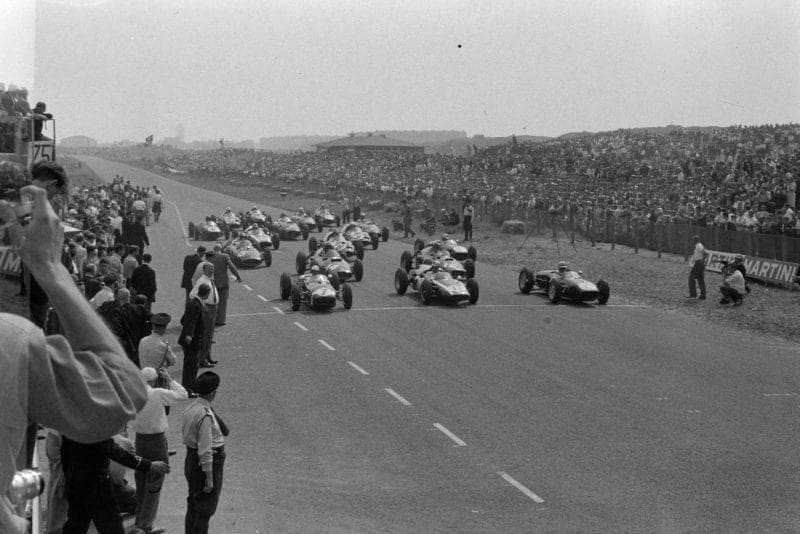
The grid anticipates the starting flag
Motorsport Images
Until now the weather had been wonderful, if somewhat sticky, but on the Monday morning rain fell in torrents and things looked ominous, but by the time the race was due to take place, at 3:15pm, the warm, dry weather was back again and everyone was happy. Altogether 17 Cars lined up before the pits and set off on a warming-up lap; a sensible arrangement this. Hill and von Trips were using small aero-screens on their Ferraris, while Ginther had a wrap-round screen, all three ears being the all-independent front-engined models. Moss had splash guards tilted to his Lotus, but they were removed when the rain threat disappeared.
As Bristow motored round the circuit on his warming-up lap his Yeoman Credit Cooper died on him, luckily on the loop just behind the pits, but it was a Iong time before his mechanics realised this for they were expecting him on the starting grid with the other 16 cars and were looking up the long straight for him. With only a few minutes to go they ran to his aid, to find that a pivot in the throttle linkage had worn right through and fractured. While the rest of the held were being assembled on the grid the Yeoman Credit Mechanics worked at high speed fitting a complete new throttle linkage assembly, which they had in the pits, and Bristow deserved every praise tor standing quietly by while they got on with the job. Many more experienced drivers would have been leaping up and down and shooting and yelling in such a situation. Finally the car was started but there was no time to complete the warming-up lap for the grid was already in order and waiting to go, so the light green car was hustled through the straw bales on the edge of the circuit and rushed into its place on the third row, the organisers very decently having taken a long time to give the 3-min.-to-go signal.
“Trintignant went by like a rocket and frightened Brooks back into his place”
As the flag was raised Brooks started creeping from the fourth row until he was alongside his team-mate in the third row, while at the back Trintignant was more than ready to go. It was a first-class start, clearly given with no fuss and bother, and all 17 cars shot away towards the first corner. Having crept forward, Brooks was right behind Graham Hill but the BRM made a hesitant start compared with the rest and Brooks was badly baulked. As he tried to turn left towards the outside of the track Trintignant went by like a rocket and frightened Brooks back into his place. The little Frenchman had been told that if he could get into the first to in the opening stages of the race he would get paid starting money, so the Cooper-Maserati was put on the line with only a gallon of fuel in the tank and Trintignant was out to do a sprint-race, unbeknown to the rest of the field.
Phil Hill had made a terrific start from row five and at the end of the first lap he was in fifth place, behind Brabham, Moss, Ireland and Stacey. Trintignant was already in 13th place. It needed only three laps of the 75 for a pattern to form, and that was Brabham out in front with Moss sitting quietly behind him, then a short gap and Ireland and Stacey running neck-and-neck, passing and re-passing, obviously not having been given any team orders, then McLaren on his own, and, already some way back, Phil Hill, Gurney, Bristow, Ginther, Bonnier, Graham Hill, Brooks, Clark and Trintignant running nose-to-tail and waiting an opportunity to sort things out. Taylor and de Beaufort quietly brought up the rear. On the fifth lap Brooks stopped behind the pits with a broken gearbox, while Trintignant was displaced by Clark and von Trips.
On the next lap Gurney, Bristow and Phil Hill got away from the others and formed a race on their own. Clark roared by Bonnier and just led Graham Hill, while Trintignant passed von Trips and Bonnier and took 12th place, for it was obvious that the Swedish driver’s BRM engine was not going properly. At the end of only eight laps McLaren’s Cooper broke the inboard universal joint on its left-hand drive shaft as he passed the pits, and he coasted to rest at the large radius Tarzan hairpin, so Trintignant was now 11th.
By 10 laps Brabham and Moss were 17sec ahead of the two works Lotus. Ireland and Stacey still running wheel-to-wheel, so that one either had to decide that Ireland was driving badly or that Stacey was driving brilliantly. They were both driving fast for they were holding on to third and fourth positions, well ahead of Gurney, who was 30sec behind the leaders in fifth position. Bristow had disappeared from the BRM’s slipstream when his engine seized up, and then Gurney disappeared quite literally from the race. As he came down the straight past the pits at 140mph and braked for the Tarzan hairpin a pipe to the rear brakes broke, and with his front wheels locked he went straight on over the bank and down quite a considerable drop, being very lucky to escape with only minor abrasions. Bristow having retired, Trintignant moved up to 10th place, but he had von Trips almost alongside him and was having to drive like a maniac to make sure of his loth place, but having done so he stopped on lap 12 to take on fuel and start the serious business of motor racing.
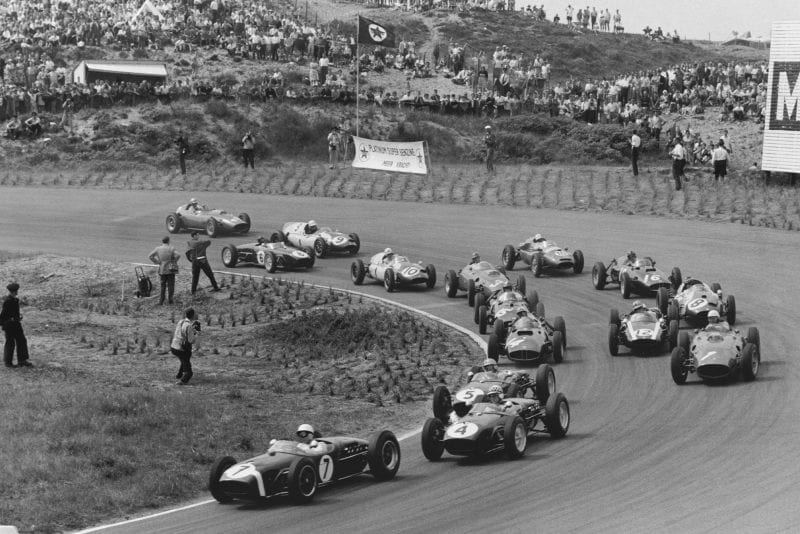
Moss leads the pack
Motorsport Images
On the 16th lap Brabham and Moss were still nose-to-tail, the Lotus obviously biding its time before passing the Cooper, and as they went through the woods on the far side of the circuit on their 17th lap Brabham put his wheels down on the inside of a curve, over the edge of the track, as he had been doing all along, but one of the large flat granite squares which arc sunk into the sand to mark the edge of the track, broke in two and the Cooper’s rear wheel picked up one piece, about the size of a good book, and flung it at the Lotus. This was on a left-hand curve and Moss was leaning on his outside front tyre when there was a crash and this huge lump of granite smashed the wheel rim and burst the tyre. He limped back to the pits while Brabham went on his way.
“Moss was leaning on his outside front tyre when there was a crash and this huge lump of granite smashed the wheel rim and burst the tyre”
The pit stop was a real laugh. First the jack would not go under the front suspension with the car sitting down on one side, and then came the absurd business of dismantling the hub and roller races in order to get the wheel off and another one on, for Lotus design, like Cooper, does not envisage changing wheels in a hurry. Of course, while all this was going on everyone stormed past, and Brabham was just appearing for the second time when Moss rejoined the race.
There were thirteen cars still left in the race and Moss was 12th; but it was obvious that he was not going to stay there for long, and he started one of those outstanding drives of his, where he is against impossible odds but refuses to give in and fights every inch of the way. Brabham was fairly safely out in front, 27sec ahead of Ireland, who was still playing games with Stacey, while further back Clark was doing a splendid job harrying Graham Hill’s BRM, Then came the three Ferraris in line-ahead, making a nice noise if nothing else, with Ginther leading, and then Brabham was round again, having lapped the rest of the field, which consisted of Bonnier on his own, Trintig-nant. Taylor and de Beaufort.
Moss was gaining 2sec a lap on Brabham but there was no need for the Australian to hurry unduly for there was no possible chance of Moss catching him, unless, of course, the Cooper ran into trouble, but the rest of the runners were not so comfortable. Although Brabham was leading the race he now became rather overlooked, for he was circulating quietly and consistently on his own, but behind, Ireland and Stacey still appeared to be having a private duel, though in fact they were just keeping each other company, but Clark was giving Graham Hill a had time, and on lap 29 he went by the BRM as they passed the pits, but the Lotus then ran wide on the hairpin under braking and the BRM got back into fourth place.
The same thing happened on the next lap but then the Lotus began to develop trouble in its transmission and Clark had to drop back a bit. Brabham lapped all the Ferraris, Phil Hill having slowed due to erratic throttles, and Ginther had conceded sixth place to von Trips but was sitting. close behind him. On lap 40 Trintignant failed to come round, as the transfer gears between engine and gearbox had broken, and on the next lap Phil Hill came in to have his carburetters looked at. Clark was making despairing signs at his gear-lever and on lap 43 he retired as something had broken between the engine and the rear wheels.
There were now only four drivers on the same lap, Brabham, Ireland, Stacey and Graham Hill, in the order Cooper, Lotus, Lotus, BRM. Moss was still going as fast as ever, lapping in 1min 34.4sec on lap 39 to set a new record, and he was in sixth place between the Ferraris of von Trips and Ginther, and was soon going to be fifth. He was also just behind the two works Lotus on the road, about to get back onto the same lap as them, but not yet back on the same lap as Brabham. The dark blue Lotus roared past the two green ones, and as their pit staff had never told them who was leading the race, merely telling them they were second and third, they assumed Moss was in the lead and were depressed when he lapped them.
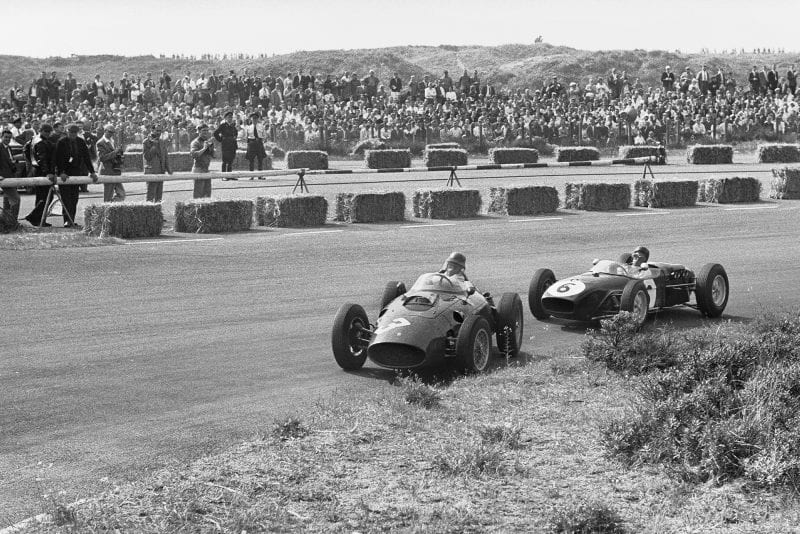
Clark chases Ginther
Motorsport Images
Phil Hill was still in dire trouble, with what now sounded like electrics, the engine cutting in and out violently, and he finally gave in. On lap 58 Ireland came by on his own and Stacey came slowly into the pits, something having broken in his transmission, as had happened to Clark, so Graham Hill was now third, and as Moss had overtaken von Trips he was now fourth, 46sec behind the BRM. Bonnier had been drifting aimlessly along at the back of the field until he was lapped by von Trips, whereupon he seemed to wake up and start going quite fast again, but then the oil-filter bowl came adrift and before he knew what had happened all the oil fell out over his rear wheels; the engine broke and he spun off the track, bending the BRM but escaping any personal injury.
With 15 laps to go the only possible thing that Moss might achieve was fourth place from Graham Hill, and many drivers in his position would have given up trying, but not “Golden Boy”. He was still driving as hard as the Lotus would go and gobbling up the seconds between himself and the BRM, and in the process he caught and passed Brabham, who was touring along in the lead.
“The only possible thing that Moss might achieve was fourth place from Graham Hill, and many drivers in his position would have given up trying, but not ‘Golden Boy’”
This put him on the same lap as Brabham but 1min 34.5sec behind him. The BRM team were signalling Hill the closing gap in seconds and giving him the faster signal, and the quiet and unruffled Graham was doing sums in his head, working out “so much a lap for so many laps equals” and driving a very fast and smooth race, refusing to let the pressure of Moss and the excitement of the spectators disturb him.
Moss was catching the BRM at around 4sec a lap and when Brabham completed his 75th lap to actually win the race no one seemed very interested, nor did they when Ireland arrived home second. Meanwhile the BRM and the Lotus were round the back of the circuit and within sight of one another. All eyes were turned up the long finishing straight, but as the two cars came into view the outcome was settled, Moss had failed, or should one say Graham Hill had succeeded. Whichever way it made a splendid finish to the race, and to cap things the last lap Moss did was in 1min 33.8sec, which was another new lap record.
